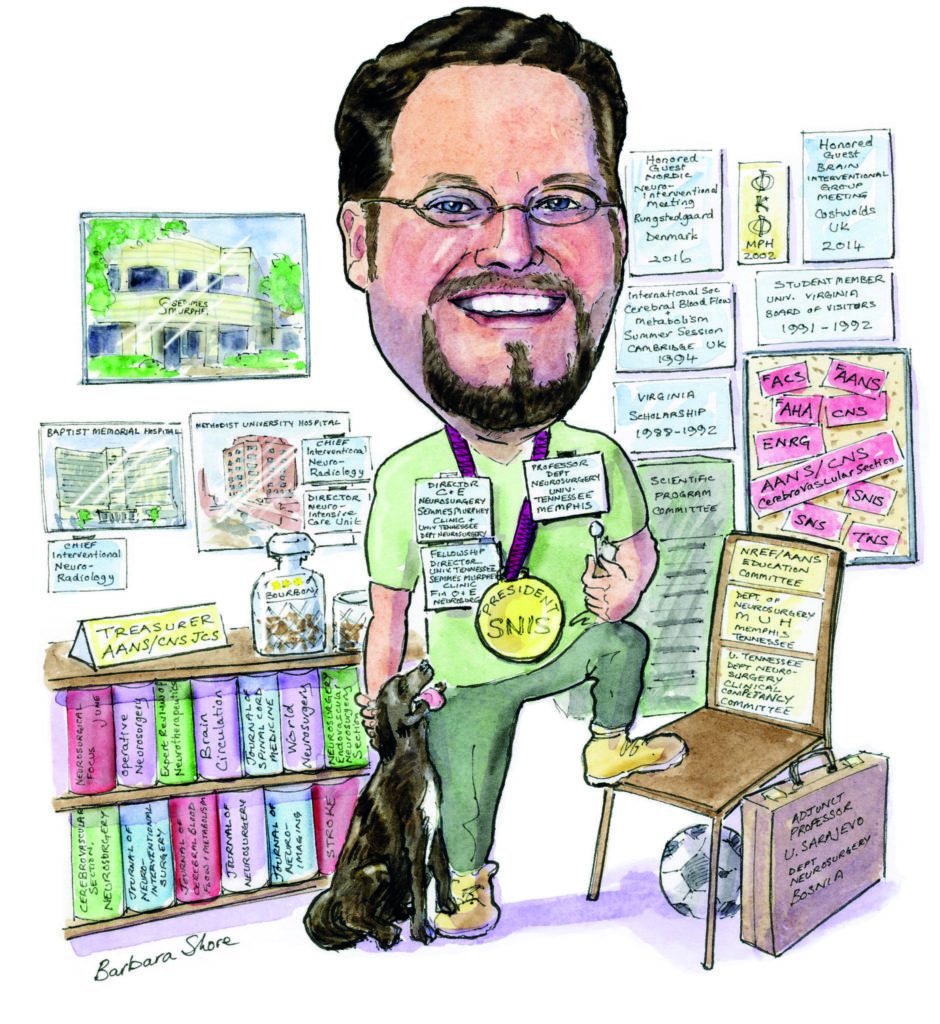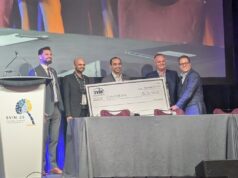 Adam Arthur was one of few neurosurgeons in the USA to develop a busy practice in both open cerebrovascular surgery and endovascular neurosurgery. As is so often the case, he has had an array of influential mentors that helped guide him as he paved his career path. Now, as the current president of the Society of NeuroInterventional Surgery (SNIS), he tells NeuroNews about the important trial results he is awaiting this year, the highlights of the 2019 meeting, and the specific technology he is looking forward to seeing evolve.
Adam Arthur was one of few neurosurgeons in the USA to develop a busy practice in both open cerebrovascular surgery and endovascular neurosurgery. As is so often the case, he has had an array of influential mentors that helped guide him as he paved his career path. Now, as the current president of the Society of NeuroInterventional Surgery (SNIS), he tells NeuroNews about the important trial results he is awaiting this year, the highlights of the 2019 meeting, and the specific technology he is looking forward to seeing evolve.
What drew you to medicine and neurosurgery in particular?
I love working in a team with smart, motivated people. I love getting to work with my hands, doing real things that have measurable results. I love getting to help patients, and being able to work with new technology. It is unbelievable that I get to do all of those things as a “job”.
Have you had any important mentors throughout your career? What have they taught you?
I have been lucky to have several outstanding mentors. During residency I particularly benefited from working under Dick Schmidt and Bill Couldwell at the University of Utah (Salt Lake City, USA). Both are fantastic surgeons who emphasised dedication, meticulous microsurgical technique and the importance of thoughtful surgical judgment.
My most influential endovascular mentor is John Barr. I came to Memphis because of his endovascular skills and his abilities as a teacher. I got to stay on as his partner, so it was a seven-year fellowship, which I am sure John would say was needed! As a bonus, I got to work with two neurosurgeons on the open surgical side: Clarence Watridge and Morris Ray.
There is a Persian proverb that roughly translates to “the branches with the most fruit bend lowest to the ground”. Clarence Watridge is a superb surgeon and an incredible doctor but comports himself as a humble servant. Morris Ray is an amazing surgeon but never sought to promote himself.
Since becoming an attending I have been influenced by several mentors. Dan Barrow, Jacques Dion, Alex Berenstein, and Chuck Kerber have all gone out of their way to be kind to me. It is a strange and wonderful thing to have a role model to become a friend.
The majority of your research sets out to improve the treatment of patients with cerebrovascular diseases, such as aneurysms and stroke. What sparked your interest in these areas?
Cerebrovascular anatomy is beautiful and fascinating. The brain is the most amazing thing we have yet encountered. My interest started with becoming entranced by cerebrovascular microsurgery and then I learned to love endovascular neurosurgery. Stroke—both haemorrhagic and ischaemic—is the most vicious enemy we face because it maims so many more than it kills, taking away vital capabilities from people, often with no warning.
Your Master’s degree focused on the methodology of clinical trials. What do you think makes a good research paper?
It starts with a question. The question must be well articulated and the answer must matter. The trial must be planned so that it can answer the question and then it must be executed well. Finally, there is no substitute for clear, well-organised writing. A good paper is easy to read and thought-provoking.
What has been the biggest disappointment, i.e. something that you thought would be practice-changing but was not?
I have been frustrated that, despite multiple attempts, we have failed to demonstrate the benefit of cerebral bypass surgery in clinical trials. Outside of neurosurgery, I am irritated that we still do not have flying cars. I watched the Jetsons as a kid and it is completely unacceptable that we are all still bumbling around, driving on roads and waiting at the airport.
What are the most important trial results that you are awaiting in the near future?
CREST-2 (Carotid revascularisation and medical management for asymptomatic carotid stenosis trial) will be important. In the USA we are much more aggressive about intervening on patients with asymptomatic carotid stenosis than in most other countries. CREST-2 should tell us whether that is advisable or not.
What technology are you keeping an eye on?
I am very interested in technologies for early identification of patients with emergency large vessel occlusions (ELVO) and for those with intracerebral haemorrhage. CT is an awfully big and expensive tool to use for screening and is a choke point for the treatment of stroke patients. I also look forward to the continued evolution of angiography systems. I think that interactive three-dimensional artificial intelligence assisted endovascular intervention should be possible in my lifetime.
As the current president of SNIS, what have you achieved, and what are your hopes for the future?
Neuroendovascular surgery is maturing into its own specialty despite the fact that most of us began training as radiologists, neurologists or neurosurgeons. I have been lucky to lead SNIS at a time when there is a lot happening to improve the field and what we have to offer for patients. The field is grounded in a passion for putting patients first and I hope that never changes.
What are the highlights of the 2019 meeting?
It is a phenomenal programme filled with diverse speakers and topics. There is, however, one thing that I am looking forward to above all the others. This is the first year that we will be addressed by a stroke patient. Amy Walters is one of the most brilliant and kind people I have ever met and she suffered a stroke at the SNIS meeting two years ago. We have established a lectureship in her honour and she is coming to give the first lecture. She is working through a significant aphasia and it will be an incredible moment when she gets up in front of the neurointerventional community to share her experience. There is so much happening in our field with technology, technique, and policy. It is good for us to be reminded of the patients’ experience.
What advice do you hope your mentees/students will always follow?
I hope they remember to enjoy their lives and help others to do the same.
What has been your most memorable case?
There are many that I will never forget but I can tell you about one. I cared for a young woman who had been dealt a really tough hand. Her parents had both died in an accident. She had had several heart surgeries and was dependent on an external pump while she awaited a heart transplant. She had lost all of her toes as a complication of vasopressor medications. The external pump became infected and she ruptured the first one, then a second mycotic brain aneurysm.
She was suffering terribly and was despondent when I met her. We were able to treat her aneurysms without giving her a stroke, which was a minor miracle. But it was hard to convince her that there was any chance of joy or future for her. The musician Ben Harper came to town and I reached out and asked him to come and see her. He was absolutely amazing. He serenaded her and charmed her and was late to his show because of it.
She lit up for quite a while and became an expert on Ben Harper’s music, expounding on it to anyone who would listen. Eventually, they had to operate on her heart to replace the infected pump and she bled to death around the time that my first son was born. The moments of happiness that she had before her death still burn in my memory. I wish we could have done more for her.
What are your interests outside of medicine?
Most of my family are artists and academics so I grew up with a love for art, theatre, and literature. I enjoy playing soccer and snowboarding. I am always up for sharing good food and wine with friends and family. I suppose I am most interested in my wife, who is brilliant, funny and beautiful, and in the three strange short people who live in our house with us (Merrick is 10, and Gus and Violet are eight).
Fact file:
Clinical appointments
Professor of Neurosurgery, University of Tennesee Health Sciences Center and Semmes-Murphey Neurologic and Spine Clinic 2018–Present: Chairman, Department of Neurosurgery, Methodist University Hospital, Memphis, USA
2010–Present: Director, Vascular and Endovascular Neurosurgery, Methodist University Hospital, Memphis, USA
2010–Present: Chief, Interventional Neuroradiology, Baptist Memorial Hospital, Memphis, USA
2009–Present: Director, Cerebrovascular and Endovascular Neurosurgery, Semmes-Murphey Clinic and University of Tennessee (Knoxville, USA), Department of Neurosurgery
2008–Present: Director, Neurointensive Care Unit, Baptist Memorial Hospital, Memphis, USA
Current society positions
2019–Present: Chair, NREF/AANS Education Committee
2019–Present: Treasurer, AANS/CNS Joint Cerebrovascular Section
2019–25: Member, Neuroendovascular Surgery Advisory Council, Committee on Advanced Specialty Training, The Society of Neurological Surgeons
2018–19: President, Society of NeuroInterventional Surgery
Current research (selected)
WEB-IT – International principal investigator
MIND – International co-principal investigator
RAGE – International co-principal investigator
STEM – International co-principal investigator
EVOLVE – International co-principal investigator
BRAVO – International co-principal investigator
Professional education
2004–2006 Fellowship (Open Cerebrovascular and Endovascular Neurosurgery) University of TN Health Sciences Center
2002 Masters in Public Health, University of Utah
1998–2004 Residency in Neurosurgery, University of Utah
1994–1998 Medical Degree, University of Virginia









